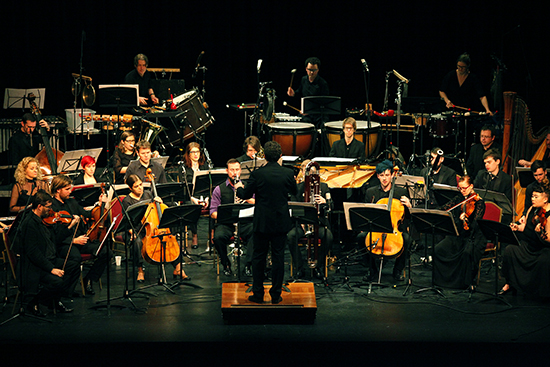The dead arise, play and dance
Zoe Barker: ELISION/ANAM, Machine for Contacting the Dead
Jason_Tavener_Photography_MACHINE__FOR_CONTACTING_THE_DEAD_MG_2486.jpg)
Carl Rosman conducts ELISION Ensemble & students from ANAM, Machine for Contacting the Dead
Speaking before the performance of Liza Lim’s Machine for Contacting the Dead (2000), conductor Carl Rosman drew parallels between the ELISION ensemble in its early days and the young musicians from the Australian National Academy of Music (ANAM) joining them for this concert. Celebrating its 30th anniversary this year and recalling how ELISION’s initial approach was to “bite off more than they could chew, and then chew like hell,” Rosman praised the young players for their similarly committed attitude towards such a daunting project.
Lim composed Machine for Contacting the Dead for France’s Ensemble Intercontemporain. Premiered in 2000, it sprang from the discovery of Chinese archaeological treasures recently excavated from a 433BCE tomb, and coincided with a Parisian exhibition of the artefacts. Among the bodies of the noblemen and concubines were several well-preserved musical instruments, some of which were unidentified. As she so often does, Lim became interested in the link between history and memory, and created this work to imagine female musicians and dancers of the distant past.
Machine for Contacting the Dead received its Australian premiere in Brisbane in 2002, performed by ELISION together with members of The Queensland Orchestra; but that’s the last we’d heard of it. A work of many challenges, perhaps its demands —or the lack of a permanent contemporary music ensemble large enough to tackle such works—had prevented it being programmed elsewhere in the composer’s home country. ELISION have found a natural match in musicians from ANAM who also joined the ensemble to perform Enno Poppe’s Speicher. Hopefully, the two will recreate this fruitful collaboration to perform similarly ambitious contemporary works in the future.
From the outset of the piece, Lim’s nimble orchestration is on show. With her highly developed ability to craft layers of sounds without overwhelming the piece’s texture, each flutter of high wind and muted brass, wail of string harmonics and punctuation points from the three percussionists helps weave a rich tapestry. While the overall effect is quite visibly and musically raucous, the volume remains understated; recalling a distant memory of imagined music.
Emerging from these memories at various points throughout, the solo cello and bass clarinet assert their presence. Cellist Séverine Ballon’s playing is exceptional. She throws herself into the highly technical and physical part, using extended techniques to make the instrument sound in unfamiliar ways. A brief duet between Ballon and ELISION veteran Peter Veale in the first movement produces some delightful interplay, with Veale’s overblown oboe a perfect match for Ballon’s suitably violent playing.

ELISION Ensemble and ANAM, Machine for Contacting the Dead, BIFEM 2016
Equally impressive is Richard Haynes, who doubled on the bass clarinet and contrabass clarinet. Seamlessly carrying on Ballon’s opening solo in the second movement, the bass clarinet at first matches the tone of the cello before diverting into an energetic and almost jazz-influenced line, punctuated by aggressive tongue slaps and jumps in register. Playing the contrabass clarinet, Haynes brings out a deep and resonant tone, with some frightening low grumbles to underscore the rest of the ensemble.
Each movement contains opportunities for individual musicians to shine. In an interview some years ago Lim hinted that, despite its commission by another ensemble, Machine for Contacting the Dead was written with ELISION musicians in mind. Marshall McGuire’s harp, with its pitch bends and sustained notes, is a great match for the piano, which switches between conventional playing and contemporary techniques including plucking the strings and bowing them with nylon wires. Trumpet flourishes are perfectly suited to Tristram Williams, who precisely executes each one, and Paula Rae’s performance shows her mastery of each of her instruments—in the shrill announcements of the piccolo and the lusty tone of the bass flute.
According to Lim’s specific instructions, the solo bass clarinet, solo cello and contrabassoon are seated front and centre. The remaining musicians surround them, meaning that instrumental families are split up. With the composer’s rich orchestration, this provides some great moments of dialogue and spatial play. A particularly effective moment is shared by the two violinists. Staring down his ANAM counterpart on the other side of the stage, Graeme Jennings’ power is evenly matched by the student in a fiery duet, with a stereo sound effect. The unique arrangement causes some problems with communication and entries, but on the whole the choice enhances the sense of space and drama in the work.
Towards the end of the final movement, attention is drawn to the back of the stage as the three percussionists, harpist and trombonist gather around the piano. With nylon wires, the five bow the grand piano strings, while the remaining percussionist ominously beats on a low bass string with her mallets. Changing the speed and intensity of the bowing wires at different rates, the effect of the pitches emerging and ringing out through the auditorium is magical. The removal of the piano lid is Lim’s own unearthing of centuries-old sonic treasures from the tomb, and a fitting end to a work which demonstrates Liza Lim’s phenomenal ability to push the boundaries of what audiences can expect to hear in a concert hall.
For another response to Machine for Contacting the Dead read Bec Scully’s review.
Bendigo International Festival of Exploratory Music, 2016: ELISION/ANAM, Machine for Contacting the Dead, composer Liza Lim; Capital Theatre, Bendigo, 4 Sept
RealTime issue #134 Aug-Sept 2016






